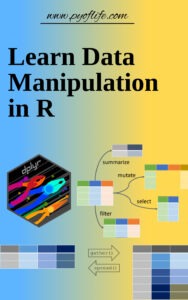Learn Data Manipulation in R: In today’s data-driven world, data manipulation is a critical skill for analysts, researchers, and data scientists. R, a powerful statistical programming language, provides numerous tools for cleaning, transforming, and analyzing data. This article will guide you through the fundamentals of data manipulation in R using easy-to-follow steps and practical examples.
Why Learn Data Manipulation in R?
R is widely used for data analysis due to its extensive libraries and flexibility. Learning data manipulation in R allows you to:
-
Clean messy datasets efficiently.
-
Transform data into a format suitable for analysis.
-
Extract meaningful insights with ease.
-
Automate repetitive data processing tasks.
With libraries like dplyr and tidyr, data manipulation in R becomes faster, more readable, and beginner-friendly. Let’s explore these libraries and essential functions for data manipulation.
Getting Started: Setting Up R and RStudio
Before diving into data manipulation, ensure you have R and RStudio installed:
-
Download and Install R: Download R.
-
Install RStudio: A popular IDE for R. Download RStudio.
-
Install Required Packages: Use the following commands to install the key libraries:
install.packages("dplyr")install.packages("tidyr")install.packages("readr")Load the libraries with:
library(dplyr)library(tidyr)library(readr)

Importing Data into R
You can import data into R from various sources like CSV files, Excel sheets, or databases. Here’s an example to import a CSV file:
# Import data from a CSV filemy_data <- read_csv("data.csv")# View the first few rows of the datasethead(my_data)The read_csv() function from the readr package is faster and more efficient than R’s base read.csv() function.
Essential Data Manipulation Functions with dplyr
The dplyr package is the heart of data manipulation in R. It provides intuitive functions for filtering, selecting, arranging, mutating, and summarizing data. Let’s explore the key functions with examples:
1. Filter Rows with filter()
The filter() function allows you to subset rows based on conditions:
# Filter rows where age is greater than 25filtered_data <- my_data %>% filter(age > 25)2. Select Columns with select()
Use select() to choose specific columns:
# Select only 'name' and 'age' columnsselected_data <- my_data %>% select(name, age)3. Arrange Rows with arrange()
Sort your dataset by specific columns:
# Arrange rows by age in ascending ordersorted_data <- my_data %>% arrange(age)# Arrange rows in descending ordersorted_data_desc <- my_data %>% arrange(desc(age))4. Create New Columns with mutate()
Generate new columns using the mutate() function:
# Add a new column 'age_in_10_years'mutated_data <- my_data %>% mutate(age_in_10_years = age + 10)5. Summarize Data with summarize()
Use summarize() to calculate summary statistics:
# Calculate average agesummary_data <- my_data %>% summarize(average_age = mean(age, na.rm = TRUE))6. Group Data with group_by()
Combine group_by() with summarize() to analyze grouped data:
# Calculate average age by gendergrouped_summary <- my_data %>%group_by(gender) %>%summarize(average_age = mean(age, na.rm = TRUE))Cleaning Data with tidyr
The tidyr package helps you organize and clean messy datasets. Key functions include:
1. Pivot Data: pivot_longer() and pivot_wider()
Convert data between long and wide formats:
# Convert wide data to long formatlong_data <- my_data %>% pivot_longer(cols = c(column1, column2), names_to = "variable", values_to = "value")# Convert long data to wide formatwide_data <- long_data %>% pivot_wider(names_from = variable, values_from = value)2. Handle Missing Values with drop_na() and replace_na()
Remove or replace missing values:
# Drop rows with missing valuesdropped_na <- my_data %>% drop_na()# Replace missing values with a specific valuefilled_data <- my_data %>% replace_na(list(age = 0))Combining Data Frames
Sometimes you need to combine multiple datasets. You can use:
-
bind_rows(): Combine datasets row-wise. -
bind_cols(): Combine datasets column-wise. -
left_join(),right_join(),inner_join(): Merge datasets based on keys.
Example: Joining Data Frames
# Merge two datasets using left joinmerged_data <- left_join(data1, data2, by = "id")Real-World Example of Data Manipulation in R
Let’s combine everything you’ve learned so far:
# Load librarieslibrary(dplyr)library(tidyr)library(readr)# Import datamy_data <- read_csv("data.csv")# Clean and transform dataclean_data <- my_data %>%filter(!is.na(age)) %>% # Remove rows with missing agemutate(age_in_5_years = age + 5) %>% # Add a new columngroup_by(gender) %>% # Group data by gendersummarize(mean_age = mean(age)) # Calculate mean age# View cleaned dataprint(clean_data)Conclusion
Data manipulation in R is a vital skill for data analysis and statistical modeling. With the dplyr and tidyr packages, you can efficiently clean, transform, and organize your data to extract valuable insights. Whether you are a beginner or an advanced user, practicing these techniques will make you proficient in handling real-world datasets.
Start experimenting with sample datasets and explore the powerful features of R. The more you practice, the better you will become at data manipulation!
Comments are closed.